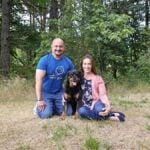


Home » Dr. Danica Burge | J-Mar Scottish Terriers

Dr. Danica Burge
1. My name is Dr. Danica Burge. I have been involved in the world of purebred dogs for over 40 years. I reside in San Jose, California, with my husband, Jon, and our daughter, London. My involvement in the world of dogs began with my parents, who started showing and breeding Scottish Terriers in the late 1960s and established the J-Mar prefix in the early 1970s—a tradition I continue today. The name J-Mar is derived from my parents’ middle names, Jerry and Marlene. We remain dedicated to the breeding, raising, and showing of Scottish Terriers. With patience and perseverance, we have achieved numerous accolades, including multiple STCA National Specialty wins, winning WB and BOW from the Bred-By class at the National Specialty in addition to many other significant awards. Our most rewarding achievement is seeing a breeding we’ve planned and worked towards come together and then have those puppies be recognized in the Breed ring.
Both of my parents, Peggy and Jerry Burge, were always active in the national and regional clubs. Both served on many committees and sat on the national Board as well as the regional breed club Boards. My Mom was a teacher by trade and in everything she did, including dogs. She was always willing to teach and mentor new people in the sport and I truly carry this on.
2. Overall, the breed maintains its quality, but certain trends merit attention. Preservation breeders must remain vigilant in upholding both health and conformation standards. While the Scottish Terrier is generally in good condition, concerns such as declining numbers, misunderstandings of the breed’s true construction, and deviations from the Breed Standard are notable. Trends like increased slab-sidedness, higher leg proportions, and insufficient forechest and rear angulation impact movement, which is characterized by a distinct rolling gait. It is essential that dogs rewarded in the ring authentically represent the Breed Standard rather than merely appearing as aesthetically pleasing entries.
3. The sport today presents both challenges and rewards. As a preservation breeder, I emphasize the importance of adhering to Breed Standards. Judging has varied perspectives; some judges adhere strictly to traditional standards, while others lack consistency. The proliferation of shows offers more opportunities, but it also risks diluting quality if not managed carefully. There is a need for patience within the community—patience with new puppy prospects, breeding programs, and the time required to achieve success. Sacrificing quality for immediate wins detracts from the long-term growth and maturation of breeding programs.
4. Montgomery epitomizes the zenith of the sport for terrier breeds. For preservation breeders, it represents the culmination of dedication and skill in maintaining breed integrity. As an exhibitor, it is a platform to showcase the finest achievements of breeding programs and honor the tradition of terriers. For me, Montgomery signifies the true beginning of the fall season, marked by the sight of terriers amidst the falling leaves. Growing up attending Montgomery, first with my parents and now with my daughter, has been a cherished tradition. The event embodies a vibrant community of terrier enthusiasts, culminating in a celebration of our shared passion.
5. Social media has both beneficial and detrimental effects on the sport. It provides valuable opportunities for education, networking, and breed promotion, facilitating the sharing of knowledge among breeders and enthusiasts. However, it also risks spreading misinformation and placing undue pressure on breeders to achieve quick results without sufficient expertise. While social media’s presence is enduring, we must navigate it thoughtfully, leveraging its potential to engage new participants and educating them about the sport and potential additions to their homes.
6. One of the primary challenges today is the lack of commitment to fully understanding the intricacies of the sport. The issue of patience extends beyond immediate results to include a broader need for community engagement. Unlike earlier times when breeders would engage in communal activities, today’s participants often miss out on the value of in-person interactions. Building a supportive community through mentorship and active engagement can help to address these challenges. We need to foster a culture of learning and patience, both in developing breeding programs and in participating in the sport.
7. Over the past decade, there have been several positive changes in the sport, including greater inclusivity and the continued success of the sport despite various challenges. Advances in veterinary medicine have significantly benefited breeders, owners, and enthusiasts, offering improvements in reproduction, orthopedics, health testing, and disease treatment. These innovations contribute to the overall advancement and well-being of the sport. We also always need to look to the future and our ability to encourage the next generation, so I am a big fan of Johnny Shoemaker’s Pee Wee Class Special Attraction. Getting the kids excited and included also helps to include and excite their parents and families. What better way to get involved than to see your child, grandchild, or friend smile as they show off their dog and hear the cheers around the ring.